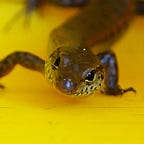Monarch of the Swamp
For cormorants, it’s sink AND swim
Water levels are low at Nyleta Wetlands/Hasties Swamp.
They expose a muddy shore that encourages wading birds to stop by. Stilts and dotterels share the expanding edge with occasional Marsh and Sharp-tailed Sandpipers. Dense thickets of Slender Waterpepper (Persicaria decipiens, Polygonaceae) have died back. With the plant’s disappearance, Plumed Whistling-ducks, who liked to snooze among its grassy stems, have moved on to thicker pastures. Wandering Whistling-ducks have replaced them. Wanderers don’t much care for flooded jungles.
Although the water has receded, it is still deep enough in spots to attract Little Pied and Little Black Cormorants. They chase Northern Purple-spotted Gudgeon (Mogurnda mogurnda, Eleotridae) through the weed. It’s hit and miss. Sometimes they surface with a flapping fish; sometimes with a bill full of stiff, muddy twigs.
While ducks bob around on the surface, cormorants lie low in the water. (Although not as low as darters, who swim with a fully submerged body and head and neck sticking up like a periscope.)
